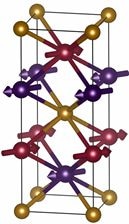Jan 31 2018
In the emerging field of spintronics, particularly spin-based electronics, information is usually described by the magnetization organization of the ferromagnets. In the recent times, scientists have also been curious to use antiferromagnets - materials that do not have macroscopic magnetization but in which microscopic magnetic moments are in a staggered orientation.
 Crystal structure of Mn2Au with antiferromagnetically ordered magnetic moments. (Image credit: Libor Šmejkal)
Crystal structure of Mn2Au with antiferromagnetically ordered magnetic moments. (Image credit: Libor Šmejkal)
In this case, encoding information is done in the direction of modulation of the magnetic moments - the well-known Néel vector. In general, antiferromagnets permit considerably faster writing of information and are highly stable even under distracting external fields. However, these benefits also indicate a difficult evaluation and read-out process of the Néel vector orientation. To date, this had been possible by adopting the copper manganese arsenide (CuMnAs) only, which is a semimetal and a compound that has a number of application related drawbacks.
As reported in Nature Communications, an online science journal, researchers from the Institute of Physics of Johannes Gutenberg University Mainz (JGU) could now demonstrate current-induced switching of the Néel vector for even metallic thin films of a compound comprising of gold and manganese (Mn2Au), which is antiferromagnetically ordered at higher temperatures. Specifically, they evaluated the magnetoresistance to be 10 times larger than it was noticed for CuMnAs. The astonishing magnitude of this effect is accounted for by extrinsic scattering on surplus gold atoms, as derived from computations performed by Libor Šmejkal, who has now collaborated with the Czech Academy of Sciences to carry out his Ph.D project in the team of Professor Jairo Sinova at Mainz University.
These calculations are very important for the understanding of our experimental work mainly performed by Stanislav Bodnar, who is a Ph.D student in our group. We identified Mn2Au as a prime candidate for enabling future antiferromagnetic spintronics. Aside from the large magnetoresistance of this compound, other important advantages are its non-toxic composition and the fact that it can be used even at higher temperatures.
Dr. Martin Jourdan, Project Leader
Spintronics is a principal area of research at the Institute of Physics at Johannes Gutenberg University Mainz, mainly undertaken by the teams of Professor Jairo Sinova (theory) and Professor Mathias Kläui (experiment). The Transregional Collaborative Center Spin+X of TU Kaiserslautern and Johannes Gutenberg University Mainz financially supported the research.